Author: William Dickerson, Filmmaking Department, New York Film Academy Los Angeles
While the one-shot master, or oner, is impressive, it’s most impressive when executed in service of the story, not in service of showmanship. Alfonso Cuaron’s famous one-shot master from Children of Men is an example of the former.
In the most extreme sense, a moving camera can delineate the beats of a scene without much, if any, change in the actors’ blocking. A moving camera has the ability to capture a variety of shots within the shot, thereby isolating specific beats solely through the placement of the frame on the subject—in this case, five actors inside a moving vehicle. As the word implies, the beat is the pulse of the film. It’s what drives the story forward. Technically, it’s a division in a scene where the action takes a turn, the momentum shifts, and one or more characters adapt, or change, to the shift. As directors, it’s imperative that we determine what the beats are, before we even think about directing the film; as directors, we shoot the beats. While Cuaron chose to shoot his car scene in one shot, he did not forget about shooting the beats—there are 17 of them, and he conveys each of them with crystal clarity.
Here’s the premise of the film: In 2027, a chaotic world in which women have somehow become infertile, a former activist agrees to help transport a miraculously pregnant woman to a sanctuary at sea.
The Beats:
1.The car radio crackles: it conjures nostalgia, introducing a song from 2003, a time when people refused to accept the future was “right around the corner.”
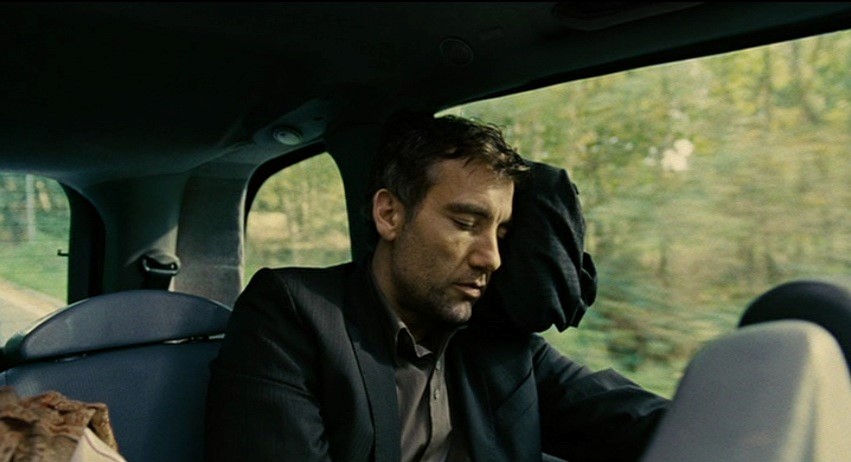
Cuaron begins the shot with a close-up single on Theo (Clive Owen), who is sleeping against the window. He pulls out to a wide to reveal the others in the car. This is referred to as slow disclosure, the revealing of the full context of a situation to the audience.
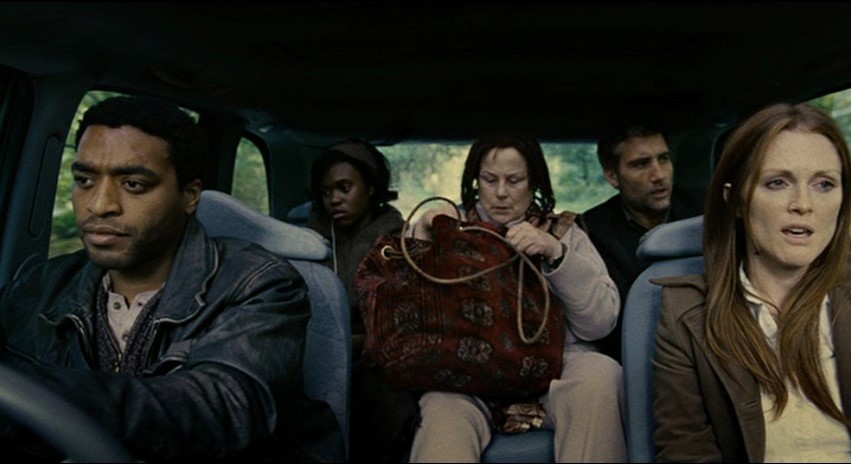
2. In this wide frame, dialog exposition reveals a previous relationship between Theo and Julian (Julianne Moore); he questions the girl they’re transporting about what she’s done, why she’s special. There’s a cynicism in his questions: he’s not an activist anymore; he’s part of the system now.
Theo is going out of his way to separate himself from them: he’s not like them anymore.
3. The third beat begins with a medium close-up of Theo and Julian together. Visually, they are not separate, but equal, subtext that is furthermore strengthened with the use of a prop: the ping-pong ball.
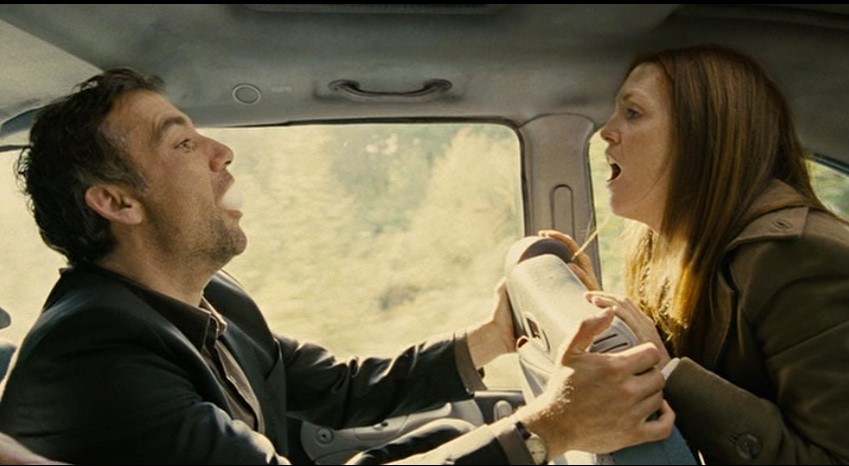
Not only is he her equal, he is the only one who can “perform” this trick with her. Cuaron isolates them in this frame; it’s as though they’re the only ones in the car, oblivious to those around them or the passing trees outside.
4. As Theo and Julian mime a kiss, the girl comments on it, disapprovingly, and the camera moves toward her—a move motivated by Theo’s look, and subsequently, the spitting of the ball at her.
5. The camera turns 180 degrees, looking through the windshield as a burning car rolls from the woods into the street, obstructing the vehicle’s path.
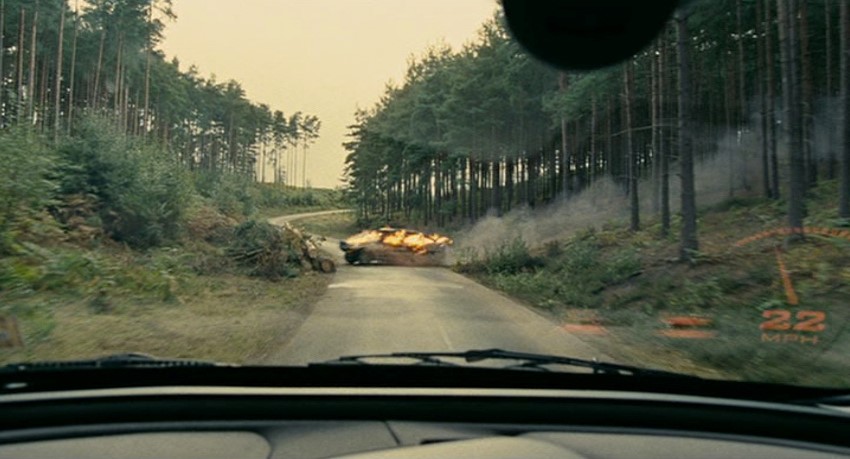
6. The camera begins a 360 move, first framing the driver—who hasn’t been featured much in the scene—and then framing everyone else in car, and in noticeably tighter shots than before. Initially, the frame was looser, the feeling in the car more casual; however, as the urgency of the circumstances increases, so does the tightness of the shots.
The camera begins to go in reverse—in fact, the entire vehicle and camera rig goes in reverse—thus visually conveying a literal turn of events.
They were moving forward with their mission, until an obstacle occurred, which has now set them moving backwards. It is a major turning point in the scene, and a major turning point for the camera. Whereas before, the characters were focused on themselves, looking at each other inside the car, now they become completely focused on what’s happening outside.
The viewer is as well. We are literally put in the middle of it all; we feel just as vulnerable as they do. Just as the characters’ world is spinning out of control, the camera is, and that’s how we’re forced to see it.
7. The camera once again stops, framing up the windshield.
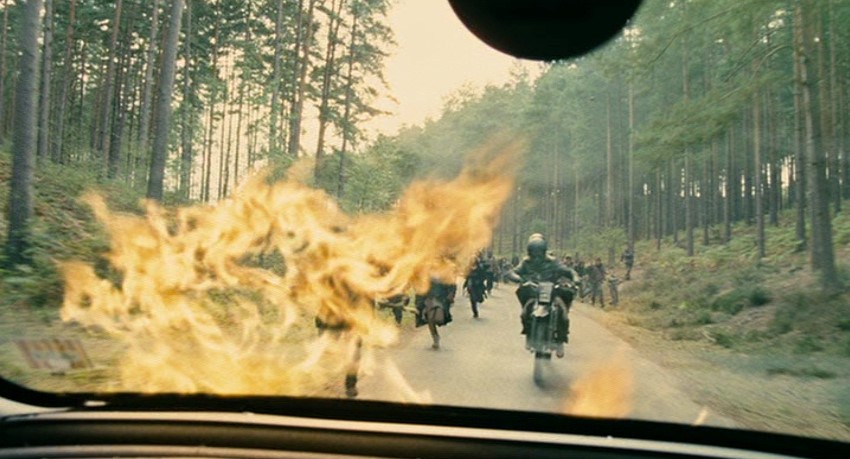
Moments before, Cuaron depicted a burning car in the distance, but now it is his characters’ windshield that is on fire. The characters go from observing a burning car to being the burning car.
As the beats progress, the drama builds and the stakes continue to increase.
8. The camera then begins to follow the movement of the attacking motorcyclist, i.e. the threat to the safety of the people inside the car. The camera is right next to Julian as she gets shot, the blood splattering onto the glass of the lens.
9. Immediately after the gunshot, the camera whips back to film the reactions of the people in the backseat, settling on Theo as he attempts to treat Julian’s wound and then, moments later, defend himself against the motorcyclist.
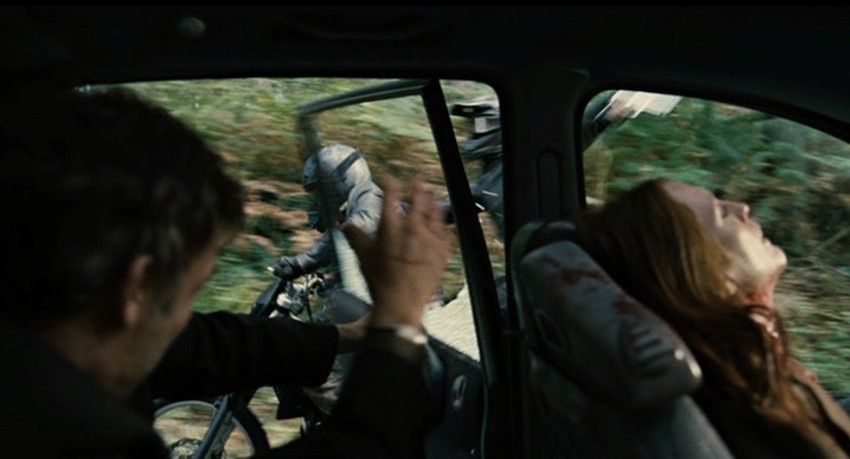
10. The camera then moves its perspective onto the driver and the cracking windshield, throwing the focus onto the seaworthiness of the car, and in doing so, ramping up the suspense once again: Will they make it out of this? Will the car hold up and will the driver get them out of this?
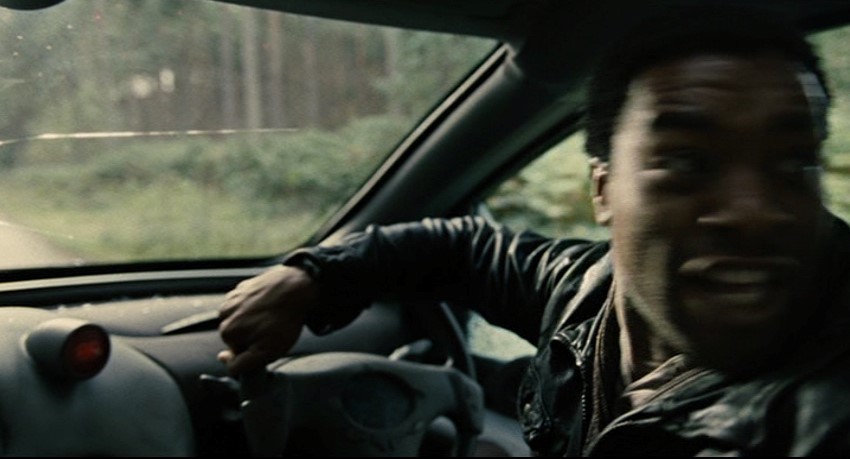
11. The camera twists back to Theo and Julian, once again isolated, together in the frame (see Beat 3); however it’s the opposite of before. She is facing away from him, dying in his arms. The nurse eventually enters frame, attempting to help in the situation, and transforming the 2 shot into a 3 shot.
12. The camera turns back to the driver, resting its point of view ostensibly with him as we see a police car drive toward, and then eventually past, them.
13. The camera turns, framing the rear window over-the-shoulders of Theo and the Nurse.
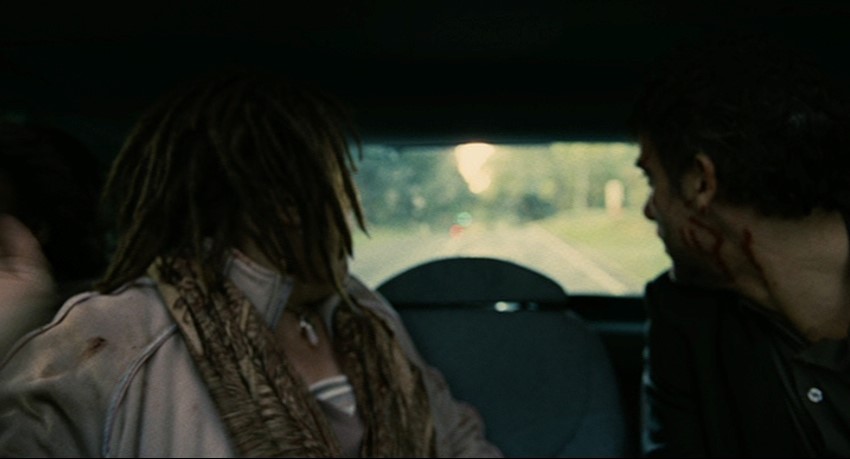
Once again utilizing slow disclosure, the camera pulls back to frame the characters in a wide shot, weighing the frame toward the driver as it racks focus onto his face: clearly, it implies, the driver has the most at stake here if the cops catch them.
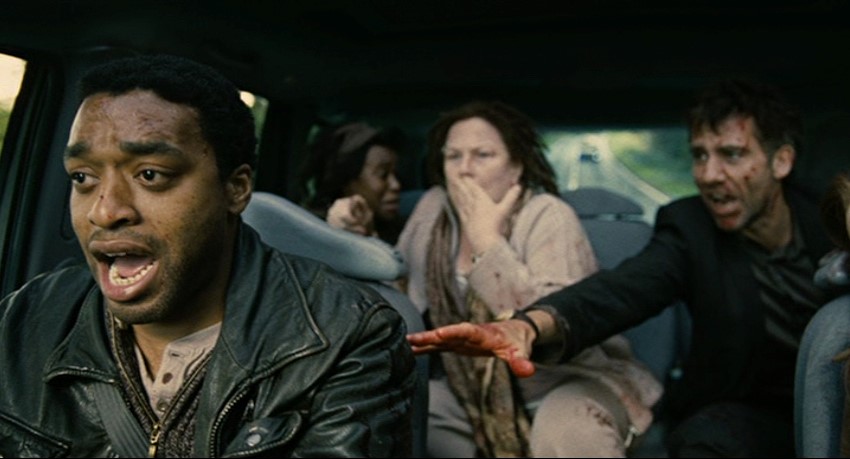
14. As with the motorcyclist, the camera movement becomes motivated by the police—another threat to them and their mission—moving with the police officers as they exit their car and approach.
15. As the officer speaks with the driver, the camera falls back into Theo’s point of view.
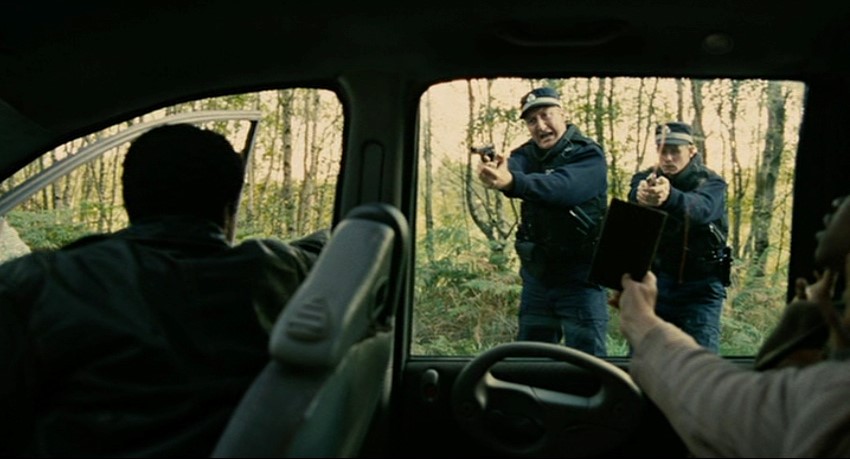
The two policemen are framed through the closed window—everyone else in the car obverses them, while the driver has his door open and physically interacts with them without a barrier.
16. As the driver shoots the police officers, the camera gets out of the car just as Theo does, moving right along with him.
At the beginning of the scene, everyone in the car was facing the same way, joined together on the same mission. Theo now finds himself on the opposite side of the driver—his gun, the car and line of the road separating them physically. The mission has veered into a direction Theo neither expected, nor approves of.
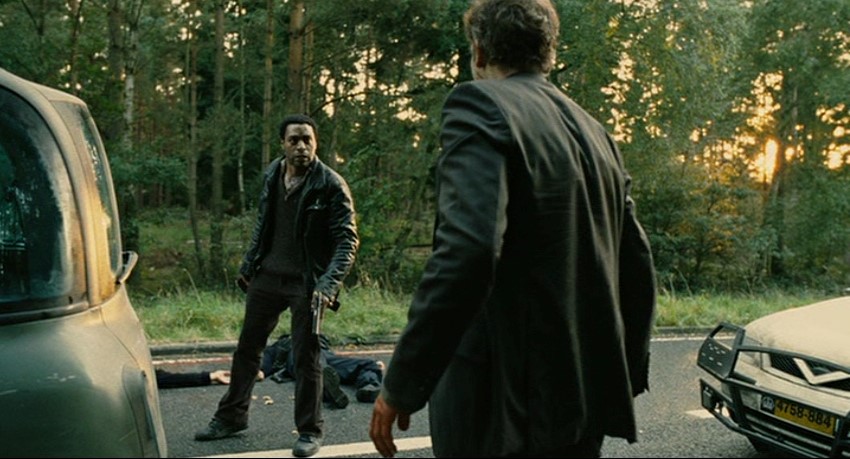
17. While Theo is forced back into the car at gunpoint, the camera is left on the side of the road—presumably where Theo would have liked to remain himself—as the car speeds away from the lens.
Alfonso Cuaron is a master of shooting the beats, whether he sets about capturing them in one shot or several. The above shot from Children of Men is a superlative example of the importance of delineating the beats of a scene. Cuaron meticulously crafted each of these 17 beats and the transitions between them—they are 17 reasons why this is one of my favorite one-shot masters of all time.